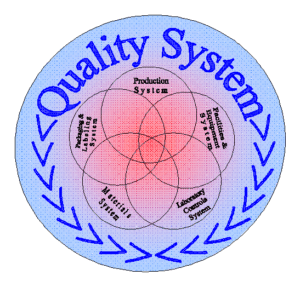ISO/IEC 17025: Supporting quality management in the lab
ISO/IEC 17025:2017 General requirements for the competence of testing and calibration laboratories is an internationally recognized standard that places requirements on testing, calibration, and sampling laboratories to demonstrate “the competence, impartiality, and consistent operation” of their business activities.[1] At its core, the standard places a strong focus on implementing procedural and quality management mechanisms (e.g., a quality management system or QMS) as a means towards meeting those goals. The first iteration of the standard, ISO Guide 25 Guidelines for assessing the technical competence of testing laboratories, published in 1978, sought to gain international cooperation towards improving the world’s laboratory services by promoting a scheme for accredited laboratory test results, such that the results could be more readily accepted across national borders.[2][3][4]
ISO/IEC 17025 eventually came along from ISO Guide 25, specifically targeting not only testing labs, but also calibration and sampling laboratories. ISO/IEC 17025 expands from its predecessors (and similar standards like ISO 9001, which addresses any type of organization) into a toolbox of requirements for ensuring not only quality but also the “competence, impartiality, and consistent operation of laboratories”[1], while also addressing “the qualifications needed with regard to personnel, equipment, facilities, and laboratory methods.” [5]
How supporting laboratory quality management improves society
While ISO/IEC 17025 certainly addresses laboratory quality, how does that benefit society? It’s useful to first examine the importance of the laboratory itself to society. In the LIMSwiki guide The Laboratories of Our Lives: Labs, Labs Everywhere!, the first chapter emphasizes the ubiquity of the laboratory in the fabric of society, despite the lab being largely invisible to the average individual [6]:
“Laboratories play an integral role in modern life, ubiquitous and often unseen by the average person. They improve quality of life, act as hotbeds of discovery, and help us make sense of our universe, particularly in the capable hands of the tens of thousands of professionals who work in them. But the laboratory as we know it today is actually a relatively new concept. It wasn’t always as sectionally organized, well-staffed, and well-equipped. To gain a better sense of how common the laboratory is to our lives, we must first briefly look at the past history of laboratory research and how it developed from a philosophical and more selfish endeavor to one more focused on analysis and the benefits to society.”
Labs are also important to society as a hotbed of economic activity, as found with the United States’ Argonne National Laboratory in Illinois, which claimed in 2021 to employ more than 3,400 people and have an approximately $168 million total economic impact on the state.[7] Additionally, labs can be a significant source of innovation to society, with the old Bell Telephone Laboratories at its peak employing some 1,200 PhDs and being responsible for the creation of vital technologies such as solid state components, wireless telephony technology, the C programming language, and the Unix operating system.[8] In fact, laboratories are often at the heart of a company’s R&D efforts towards bringing people new products. Clinical labs help keep current and future generations healthy, and forensic labs help bring justice to the wronged. Of course, calibration laboratories are vital to ensuring the precise measurement and production values of any equipment those other laboratories strongly depend on.
However, labs can and do fail (completely, or at their tasks)[9][10][11], like any other business. This can happen for a number of reason[9][10], though insufficient attention to risk and quality management is usually a major contributor.[11][12][13] In fact, data and quality management are arguably at the heart of aiding not only in reducing errors in laboratory processes but also more rapidly recovering from errors in and strengthening the quality of processes.
Labs of all types should be addressing quality and planning operations with the concept in mind. This includes food and beverage laboratories, water and wastewater laboratories, and calibration laboratories, among many others. Past research has shown that a well-implemented quality plan, paired with quality indicators, is significantly associated with improving laboratory services and client satisfaction.[14] In particular, the customer or client is increasingly seen as the most important element driving laboratory quality, supported by effective QMS implementation and improvement, like that driven by ISO/IEC 17025. “A QMS with customer focus as its heart is the core foundation for a business striving to attain distinction irrespective of technology, commercial strategy or organizational philosophy,” notes Udoh and Eluwole, adding that “at the end of the day, the quality of a product will be determined by whether or not it fulfills customer requirements.”[15] By extension, the end user of a product or service will be not only more satisfied but also safer for it. The Galaxy Note 7 battery explosion issue from Samsung in 2016 offers an example of what can go wrong when quality goes wrong or becomes ignored in the lab.[15][16] Other lab types—as well as their customers—that have demonstrably gained from a well-defined QMS include the clinical and public health labs[17] and food quality labs.[18]
Finally, well-enacted quality management improves overall costs and efficiency for not only the laboratory but also society.[19][20][21][22] Raiborn and Payne noted this in the mid-1990s while discussing the topic of “total quality management”[22]:
“Who benefits from prompt, reasonable-cost throughput? The answer is easy: everyone. Customers benefit because they get what they want, when they want it, and at a reasonable price. Satisfied customers are repeat customers, which means that employees benefit because production and, therefore, jobs will continue. The company benefits because shortened lead time means lowered investment and faster cash flow; satisfied, repeat customers and efficient processes also mean higher profits and, thus, happy stockholders. Society benefits because there is greater availability of resources for alternative purposes since prices have fallen (or greater value is being provided for the same price) and companies will continue in business, providing numerous positive societal effects from their existence (tax payments, employment, charitable contributions, etc.).”
While Raiborn and Payne’s quote specifically refers to improvements in costs and efficiency within the organization due to proper quality management, their words sum up quite well the overall benefits to society laboratory quality management and ISO/IEC 17025 bring. A product or service—whether it be the analytical results of the laboratory itself or the larger macro view of safer, more high-quality products and services via laboratory testing—that meets customer requirements is the end result of quality laboratory work, and society benefits from it thanks in part to well-implemented quality management mechanisms. Without them, products and services are more risky to use, more apt to have health-impeding impurities and contaminates, less beneficial, and more expensive.
References
Portions of this article were adapted from the LIMSwiki article by the same name, by the same author, Shawn E. Douglas. https://www.limswiki.org/index.php/LIMS_FAQ:What_is_the_importance_of_ISO/IEC_17025_to_society%3F
Citations for this version are:
- “ISO/IEC 17025:2017 General requirements for the competence of testing and calibration laboratories”. International Organization for Standardization. November 2017. Retrieved 26 September 2023. https://www.iso.org/standard/66912.html
- Squirrell, A. (1 September 2008). “Conformity assessment: providing confidence in testing and calibration” (in en). Accreditation and Quality Assurance 13 (9): 543–546. doi: 10.1007/s00769-008-0418-2.ISSN: 0949-1775. http://link.springer.com/10.1007/s00769-008-0418-2
- Miguel, Anna; Moreira, Renata; Oliveira, André (2021). “ISO/IEC 17025: HISTORY AND INTRODUCTION OF CONCEPTS”. Química Nova. doi:10.21577/0100-4042.20170726. http://quimicanova.sbq.org.br/audiencia_pdf.asp?aid2=9279&nomeArquivo=AG2020-0467.pdf
- Vehring, S. (June 2020). “Tested & Accepted: Implementing ISO/IEC 17025:2017” (PDF). United Nations Industrial Development Organization. Retrieved 26 September 2023. https://www.unido.org/sites/default/files/files/2020-06/Guide%20ISO%2017025-2017_online.pdf
- Perry Johnson Consulting, Inc. (January 2022). “ISO/IEC 17025:2017 Testing and Calibration Laboratories: An Executive Overview” (PDF). Retrieved 26 September 2023. https://www.pjcinc.com/Downloads/ISOIEC17025_exov.pdf
- Douglas, S.E. (July 2022). “1. Laboratories: A historical perspective”. The Laboratories of Our Lives: Labs, Labs Everywhere! . LIMSwiki. Retrieved 26 September 2023. https://www.limswiki.org/index.php/LII:The_Laboratories_of_Our_Lives:_Labs,_Labs_Everywhere!/Laboratories:_A_historical_perspective
- “Argonne Impacts State by State: Illinois”. Argonne National Laboratory . UChicago Argonne, LLC. Retrieved 26 September 2023. https://www.anl.gov/argonne-impacts/illinois
- Gertner, J. (2013). The Idea Factory: Bell Labs and the Great Age of American Innovation. Penguin. pp. 422. ISBN: 9780143122791. https://books.google.com/books?id=OkECDAAAQBAJ
- Ahuja, S.B. (22 July 2019). “Why Innovation Labs Fail, and How to Ensure Yours Doesn’t”. Harvard Business Review . Retrieved 26 September 2023. https://hbr.org/2019/07/why-innovation-labs-fail-and-how-to-ensure-yours-doesnt
- Keppel, Martin H; Cadamuro, Janne; Haschke-Becher, Elisabeth; Oberkofler, Hannes; Felder, Thomas K; Lippi, Giuseppe; Mrazek, Cornelia (15 June 2020). “Errors within the total laboratory testing process, from test selection to medical decision-making – A review of causes, consequences, surveillance and solutions”. Biochemia medica 30 (2): 215–233. doi:10.11613/BM.2020.020502. https://www.biochemia-medica.com/en/journal/30/2/10.11613/BM.2020.020502
- Parvin, C.A.; Yundt-Pacheco, J.; Quintenz, A. (2015). “Monitoring test system failures and QC performance can help identify opportunities for improvement”. QCNet . Retrieved 26 September 2023. https://www.qcnet.com/resources/qc-articles/learning-from-laboratory-failures
- Mortimer, Sharon T.; Mortimer, David (2015). “Chapter 4: What is risk?”. Quality and risk management in the IVF laboratory (Second edition ed.). Cambridge, United Kingdom ; New York: Cambridge University Press. pp. 39–48. ISBN: 978-1-107-42128-8.
- Murray, W. (10 May 2016). “Exploring Risk Management in the Lab: Risk-based decisionmaking and appropriate analytical tools can improve lab quality”. CLP Magazine . Retrieved 26 September 2023. https://clpmag.com/lab-essentials/quality-systems/exploring-risk-management-lab/
- Mulleta, Daba; Jaleta, Fraol; Banti, Haile; Bekele, Bayissa; Abebe, Wake; Tadesse, Henok; Eshetu, Legesse; Zewdu, Adinew et al. (1 July 2021). “The Impact of Laboratory Quality Management System Implementation on Quality Laboratory Service Delivery in Health Center Laboratories of Oromia Region, Ethiopia” (in en). Pathology and Laboratory Medicine International Volume 13: 7–19. doi:10.2147/PLMI.S314656. https://www.dovepress.com/the-impact-of-laboratory-quality-management-system-implementation-on-q-peer-reviewed-fulltext-article-PLMI
- Udoh, N.; Eluwole, O.T. (July 2017). “The Impact of Quality Management System in Laboratory Certification of Smartcards and Emerging Payment Technologies” (PDF). Proceedings of the World Congress on Engineering 2017, Volume II. ISBN: 978-988-14048-3-1. Retrieved 26 September 2023. https://www.iaeng.org/publication/WCE2017/WCE2017_pp738-743.pdf
- Heathman, A. (24 January 2017). “We finally know why Samsung’s Galaxy Note 7s ‘exploded’”. Wired . Retrieved 26 September 2023. https://www.wired.co.uk/article/galaxy-note-7-issues-what-happened
- World Health Organization. “Module 1, Overview of the Quality System, Introduction” (PDF). pp. 1–9. Retrieved 26 September 2023. https://extranet.who.int/hslp/who-hslp-download/package/501/material/168
- Spink, John; Moyer, Douglas C.; Park, Hyeonho; Wu, Yongning; Fersht, Victor; Shao, Bing; Hong, Miao; Paek, Seung Yeop et al. (1 December 2015). “Introducing Food Fraud including translation and interpretation to Russian, Korean, and Chinese languages” (in en). Food Chemistry 189 : 102–107. doi:10.1016/j.foodchem.2014.09.106. https://linkinghub.elsevier.com/retrieve/pii/S0308814614014824
- Rao, Dd (2021). “ISO/IEC 17025: Accreditation standard for testing and calibration laboratories” (in en). Radiation Protection and Environment 44 (3): 121. doi:10.4103/rpe.rpe_41_21. http://www.rpe.org.in/text.asp?2021/44/3/121/334784
- Garber Metrology (14 December 2021). “A Guide to ISO 17025 Calibration and Compliance”. Garber Metrology Blog . Retrieved 26 September 2023. https://www.garbermetrology.com/iso-17025/
- “What is ISO 17025?”. Advisera Expert Solutions Ltd. 2022. Retrieved 26 September 2023. https://advisera.com/17025academy/what-is-iso-17025/
- Raiborn, Cecily; Payne, Dinah (1 September 1996). “TQM: Just what the ethicist ordered” (in en). Journal of Business Ethics 15 (9): 963–972. doi:10.1007/BF00705576. http://link.springer.com/10.1007/BF00705576



